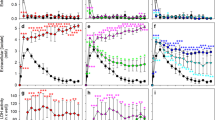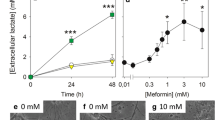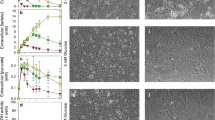Abstract
Metformin is the most frequently used drug for the treatment of type 2 diabetes in humans. However, only little is known about effects of metformin on brain metabolism. To investigate potential metabolic consequences of an exposure of brain cells to metformin, we incubated rat astrocyte-rich primary cultures with this compound. Metformin in concentrations of up to 30 mM did not acutely compromise the viability of astrocytes, but caused a time- and concentration-dependent increase in cellular glucose consumption and lactate production. For acute incubations in the hour range, the presence of 10 mM metformin doubled the glycolytic flux, while already 1 mM metformin doubled glycolytic flux during incubation for 24 h. In addition to metformin, also other guanidino compounds increased astrocytic lactate production. After 4 h of incubation, half-maximal stimulation of glycolysis was observed for metformin, guanidine and phenformin at concentrations of around 3 mM, 3 mM and 30 µM, respectively. The acute stimulation of glycolytic lactate production by metformin was persistent after removal of extracellular metformin and was also observed, if glucose was absent from the incubation medium or replaced by other hexoses. The metformin-induced stimulation of glycolytic flux was not prevented by compound C, an inhibitor of AMP-dependent protein kinase, nor was it additive to the stimulation of glycolytic flux caused by respiratory chain inhibitors. These data demonstrate that the antidiabetic drug metformin has the potential to strongly activate glycolytic lactate production in brain astrocytes.





Similar content being viewed by others
References
Bailey CJ, Day C (2004) Metformin: its botanical background. Pract Diab Int 21:115–117
Scarpello JH, Howlett HC (2008) Metformin therapy and clinical uses. Diab Vasc Dis Res 5:157–167
Rios JL, Francini F, Schinella GR (2015) Natural products for the treatment of type 2 diabetes mellitus. Planta Med 81:975–994
Viollet B, Guigas B, Sanz Garcia N, Leclerc J, Foretz M, Andreelli F (2012) Cellular and molecular mechanisms of metformin: an overview. Clin Sci 122:253–270
Nies AT, Hofmann U, Resch C, Schaeffeler E, Rius M, Schwab M (2011) Proton pump inhibitors inhibit metformin uptake by organic cation transporters (OCTs). PLoS One 6:e22163
Oshima R, Yamada M, Kurogi E, Ogino Y, Serizawa Y, Tsuda S, Ma X, Egawa T, Hayashi T (2015) Evidence for organic cation transporter-mediated metformin transport and 5′-adenosine monophosphate-activated protein kinase activation in rat skeletal muscles. Metabolism 64:296–304
Zhou G, Myers R, Li Y, Chen Y, Shen X, Fenyk-Melody J, Wu M, Ventre J, Doebber T, Fujii N, Musi N, Hirshman MF, Goodyear LJ, Moller DE (2001) Role of AMP-activated protein kinase in mechanism of metformin action. J Clin Invest 108:1167–1174
Orecchioni S, Reggiani F, Talarico G, Mancuso P, Calleri A, Gregato G, Labanca V, Noonan DM, Dallaglio K, Albini A, Bertolini F (2015) The biguanides metformin and phenformin inhibit angiogenesis, local and metastatic growth of breast cancer by targeting both neoplastic and microenvironment cells. Int J Cancer 136:E534–E544
El-Mir M-Y, Nogueira V, Fontaine E, Avéret N, Rigoulet M, Leverve X (2000) Dimethylbiguanide inhibits cell respiration via an indirect effect targeted on the respiratory chain complex I. J Biol Chem 275:223–228
Madiraju AK, Erion DM, Rahimi Y, Zhang XM, Braddock DT, Albright RA, Prigaro BJ, Wood JL, Bhanot S, MacDonald MJ, Jurczak MJ, Camporez JP, Lee HY, Cline GW, Samuel VT, Kibbey RG, Shulman GI (2014) Metformin suppresses gluconeogenesis by inhibiting mitochondrial glycerophosphate dehydrogenase. Nature 510:542–546
Gong L, Goswami S, Giacomini KM, Altman RB, Klein TE (2012) Metformin pathways: pharmacokinetics and pharmacodynamics. Pharmacogn Genom 22:820–827
Bolen S, Feldman L, Vassy J, Wilson L, Yeh HC, Marinopoulos S, Wiley C, Selvin E, Wilson R, Bass EB, Brancati FL (2007) Systematic review: comparative effectiveness and safety of oral medications for type 2 diabetes mellitus. Ann Intern Med 147:386–399
Salpeter SR, Greyber E, Pasternak GA, Salpeter Posthumous EE (2010) Risk of fatal and nonfatal lactic acidosis with metformin use in type 2 diabetes mellitus. The Cochrane database of systematic reviews. www.thecochranelibrary.com
Kajbaf F, Lalau JD (2014) Mortality rate in so-called “metformin-associated lactic acidosis”: a review of the data since the 1960s. Pharmacoepidemiol Drug Saf 23:1123–1127
Huang W, Castelino RL, Peterson GM (2015) Adverse event notifications implicating metformin with lactic acidosis in Australia. J Diabetes Complications, (in press)
Labuzek K, Suchy D, Gabryel B, Bielecka A, Liber S, Okopieñ B (2010) Quantification of metformin by the HPLC method in brain regions, cerebrospinal fluid and plasma of rats treated with lipopolysaccharide. Pharmacol Rep 62(5):956–965
McCarty MF, DiNicolantonio JJ, O’Keefe JH (2015) Ketosis may promote brain macroautophagy by activating sirt1 and hypoxia-inducible factor-1. Med Hypotheses, (in press)
Ma J, Liu J, Yu H, Chen Y, Wang Q, Xiang L (2015) Effect of metformin on schwann cells under hypoxia condition. Int J Clin Exp Pathol 8:6748–6755
Farbood Y, Sarkaki A, Khalaj L, Khodagholi F, Badavi M, Ashabi G (2015) Targeting AMPK by metformin adjusts post-ischemic hyperemia and extracellular neuronal discharge in transient global cerebral ischemia. Microcirculation 22:534–541
Gonzalez-Perez O, Lopez-Virgen V, Quinones-Hinojosa A (2015) Astrocytes: everything but the glue. Neuroimmunol Neuroinflamm 2:115–117
Parpura V, Verkhratsky A (2012) Astrocytes revisited: concise historic outlook on glutamate homeostasis and signaling. Croat Med J 53:518–528
Hirrlinger J, Dringen R (2010) The cytosolic redox state of astrocytes: maintenance, regulation and functional implications for metabolite trafficking. Brain Res Rev 63:177–188
Belanger M, Allaman I, Magistretti PJ (2011) Brain energy metabolism: focus on astrocyte-neuron metabolic cooperation. Cell Metab 14:724–738
Dringen R, Brandmann M, Hohnholt MC, Blumrich EM (2015) Glutathione-dependent detoxification processes in astrocytes. Neurochem Res, (in press)
Dringen R, Spiller S, Neumann S, Koehler Y (2015) Uptake, metabolic effects and toxicity of arsenate and arsenite in astrocytes. Neurochem Res, (in press)
Schreiner B, Romanelli E, Liberski P, Ingold-Heppner B, Sobottka-Brillout B, Hartwig T, Chandrasekar V, Johannssen H, Zeilhofer HU, Aguzzi A, Heppner F, Kerschensteiner M, Becher B (2015) Astrocyte depletion impairs redox homeostasis and triggers neuronal loss in the adult CNS. Cell Rep 12:1377–1384
Dringen R, Bishop GM, Koeppe M, Dang TN, Robinson SR (2007) The pivotal role of astrocytes in the metabolism of iron in the brain. Neurochem Res 32:1884–1890
Scheiber IF, Dringen R (2013) Astrocyte functions in the copper homeostasis of the brain. Neurochem Int 62:556–565
Bulcke F, Dringen R (2015) Handling of copper and copper oxide nanoparticles by astrocytes. Neurochem Res, (in press)
Takahashi S, Iizumi T, Mashima K, Abe T, Suzuki N (2014) Roles and regulation of ketogenesis in cultured astroglia and neurons under hypoxia and hypoglycemia. ASN Neuro 6:1759091414550997. doi:10.1177/1759091414550997
Jayakumar AR, Tong XY, Curtis KM, Ruiz-Cordero R, Shamaladevi N, Abuzamel M, Johnstone J, Gaidosh G, Rama Rao KV, Norenberg MD (2014) Decreased astrocytic thrombospondin-1 secretion after chronic ammonia treatment reduces the level of synaptic proteins: in vitro and in vivo studies. J Neurochem 131:333–347
Allaman I, Grenningloh G, Magistretti P (2015) Modulation of astrocytic glucose metabolism by the antidiabetic drug metformin. J Neurochem, Suppl. 1:260, poster WTH203-202
Tulpule K, Hohnholt M, Hirrlinger J, Dringen R (2014) Primary cultures of astrocytes and neurons as model systems to study the metabolism and metabolite export from brain cells. In: Hirrlinger J, Waagepetersen HS (eds) Brain energy metabolism. Springer, New York, pp 45–72
Petters C, Dringen R (2014) Comparison of primary and secondary rat astrocyte cultures regarding glucose and glutathione metabolism and the accumulation of iron oxide nanoparticles. Neurochem Res 39:46–58
Lowry OH, Rosebrough NJ, Farr AL, Randall RJ (1951) Protein measurement with the Folin phenol reagent. J Biol Chem 193:265–275
Luther EM, Koehler Y, Diendorf J, Epple M, Dringen R (2011) Accumulation of silver nanoparticles by cultured primary brain astrocytes. Nanotechnology 22:375101
Schmidt MM, Rohwedder A, Dringen R (2011) Effects of chlorinated acetates on the glutathione metabolism and on glycolysis of cultured astrocytes. Neurotox Res 19:628–637
Heneberg P (2009) Use of protein tyrosine phosphatase inhibitors as promising targeted therapeutic drugs. Curr Med Chem 16:706–733
Degli Esposti M (1998) Inhibitors of NADH-ubiquinone reductase: an overview. Biochim Biophys Acta 1364:222–235
Rieske JS (1976) Composition, structure, and function of complex III of the respiratory chain. Biochim Biophys Acta 456:195–247
Potter VR, Reif AE (1952) Inhibition of an electron transport component by antimycin A. J Biol Chem 194:287–297
Chong CR, Chabner BA (2009) Mysterious metformin. Oncologist 14:1178–1181
Wajchenberg BL, Halpern A, Leme CE, Lerario AC, Silveria AA, Fioratti PA, Cesar FP (1976) Mechanism of action of phenethylbiguanide (phenformin) in man. Iii. Interrelationship between ethanol and phenethylibiguanide (PBG) in normal and diabetic subjects. Metabolism 25:957–971
Kajbaf F, Lalau JD (2013) The prognostic value of blood pH and lactate and metformin concentrations in severe metformin-associated lactic acidosis. BMC Pharmacol Toxicol 14:22
Scheiber IF, Dringen R (2011) Copper accelerates glycolytic flux in cultured astrocytes. Neurochem Res 36:894–903
Tulpule K, Dringen R (2012) Formate generated by cellular oxidation of formaldehyde accelerates the glycolytic flux in cultured astrocytes. Glia 60:582–593
Tadepalle N, Koehler Y, Brandmann M, Meyer N, Dringen R (2014) Arsenite stimulates glutathione export and glycolytic flux in viable primary rat brain astrocytes. Neurochem Int 76:1–11
Brandmann M, Nehls U, Dringen R (2013) 8-hydroxy-efavirenz, the primary metabolite of the antiretroviral drug efavirenz, stimulates the glycolytic flux in cultured rat astrocytes. Neurochem Res 38:2524–2534
Courousse T, Gautron S (2015) Role of organic cation transporters (OCTs) in the brain. Pharmacol Ther 146:94–103
Shi S, Klotz U (2008) Proton pump inhibitors: an update of their clinical use and pharmacokinetics. Eur J Clin Pharmacol 64:935–951
van der Goot H, Timmerman H (2000) Selective ligands as tools to study histamine receptors. Eur J Med Chem 35:5–20
Möller A, Hamprecht B (1989) Creatine transport in cultured cells of rat and mouse brain. J Neurochem 52:544–550
Schmidlin A, Wiesinger H (1994) Transport of l-arginine in cultured glial cells. Glia 11:262–268
Dringen R, Verleysdonk S, Hamprecht B, Willker W, Leibfritz D, Brand A (1998) Metabolism of glycine in primary astroglial cells: synthesis of creatine, serine, and glutathione. J Neurochem 70:835–840
Carducci C, Santagata S, Adriano E, Artiola C, Thellung S, Gatta E, Robello M, Florio T, Antonozzi I, Leuzzi V, Balestrino M (2012) In vitro study of uptake and synthesis of creatine and its precursors by cerebellar granule cells and astrocytes suggests some hypotheses on the physiopathology of the inherited disorders of creatine metabolism. BMC Neurosci 13:41
Stienen MN, Haghikia A, Dambach H, Thone J, Wiemann M, Gold R, Chan A, Dermietzel R, Faustmann PM, Hinkerohe D, Prochnow N (2011) Anti-inflammatory effects of the anticonvulsant drug levetiracetam on electrophysiological properties of astroglia are mediated via TGFβ1 regulation. Br J Pharmacol 162:491–507
Pauwels PJ, Opperdoes FR, Trouet A (1985) Effects of antimycin, glucose deprivation, and serum on cultures of neurons, astrocytes, and neuroblastoma cells. J Neurochem 44:143–148
Almeida A, Moncada S, Bolanos JP (2004) Nitric oxide switches on glycolysis through the AMP protein kinase and 6-phosphofructo-2-kinase pathway. Nat Cell Biol 6:45–51
McKenna MC, Waagepetersen HS, Schousboe A, Sonnewald U (2006) Neuronal and astrocytic shuttle mechanisms for cytosolic-mitochondrial transfer of reducing equivalents: current evidence and pharmacological tools. Biochem Pharmacol 71:399–407
Dringen R, Hamprecht B (1993) Differences in glycogen metabolism in astroglia-rich primary cultures and sorbitol-selected astroglial cultures derived from mouse brain. Glia 8:143–149
Dringen R, Bergbauer K, Wiesinger H, Hamprecht B (1994) Utilization of mannose by astroglial cells. Neurochem Res 19:23–30
Bergbauer K, Dringen R, Verleysdonk S, Gebhardt R, Hamprecht B, Wiesinger H (1996) Studies on fructose metabolism in cultured astroglial cells and control hepatocytes: lack of fructokinase activity and immunoreactivity in astrocytes. Dev Neurosci 18:371–379
Litchfield LM, Mukherjee A, Eckert MA, Johnson A, Mills KA, Pan S, Shridhar V, Lengyel E, Romero IL (2015) Hyperglycemia-induced metabolic compensation inhibits metformin sensitivity in ovarian cancer. Oncotarget 6:23548–23560
Mueckler M, Thorens B (2013) The SLC2 (GLUT) family of membrane transporters. Mol Asp Med 34:121–138
Dringen R, Gebhardt R, Hamprecht B (1993) Glycogen in astrocytes: possible function as lactate supply for neighboring cells. Brain Res 623:208–214
Bouzier-Sore AK, Bolaños JP (2015) Uncertainties in pentose-phosphate pathway flux assessment underestimate its contribution to neuronal glucose consumption: relevance for neurodegeneration and aging. Front Aging Neurosci 7:89
Author information
Authors and Affiliations
Corresponding author
Ethics declarations
Conflict of interest
The authors have no conflict of interest to declare.
Additional information
Special Issue: In honor of Dr. Mary McKenna.
Rights and permissions
About this article
Cite this article
Westhaus, A., Blumrich, E.M. & Dringen, R. The Antidiabetic Drug Metformin Stimulates Glycolytic Lactate Production in Cultured Primary Rat Astrocytes. Neurochem Res 42, 294–305 (2017). https://doi.org/10.1007/s11064-015-1733-8
Received:
Revised:
Accepted:
Published:
Issue Date:
DOI: https://doi.org/10.1007/s11064-015-1733-8




